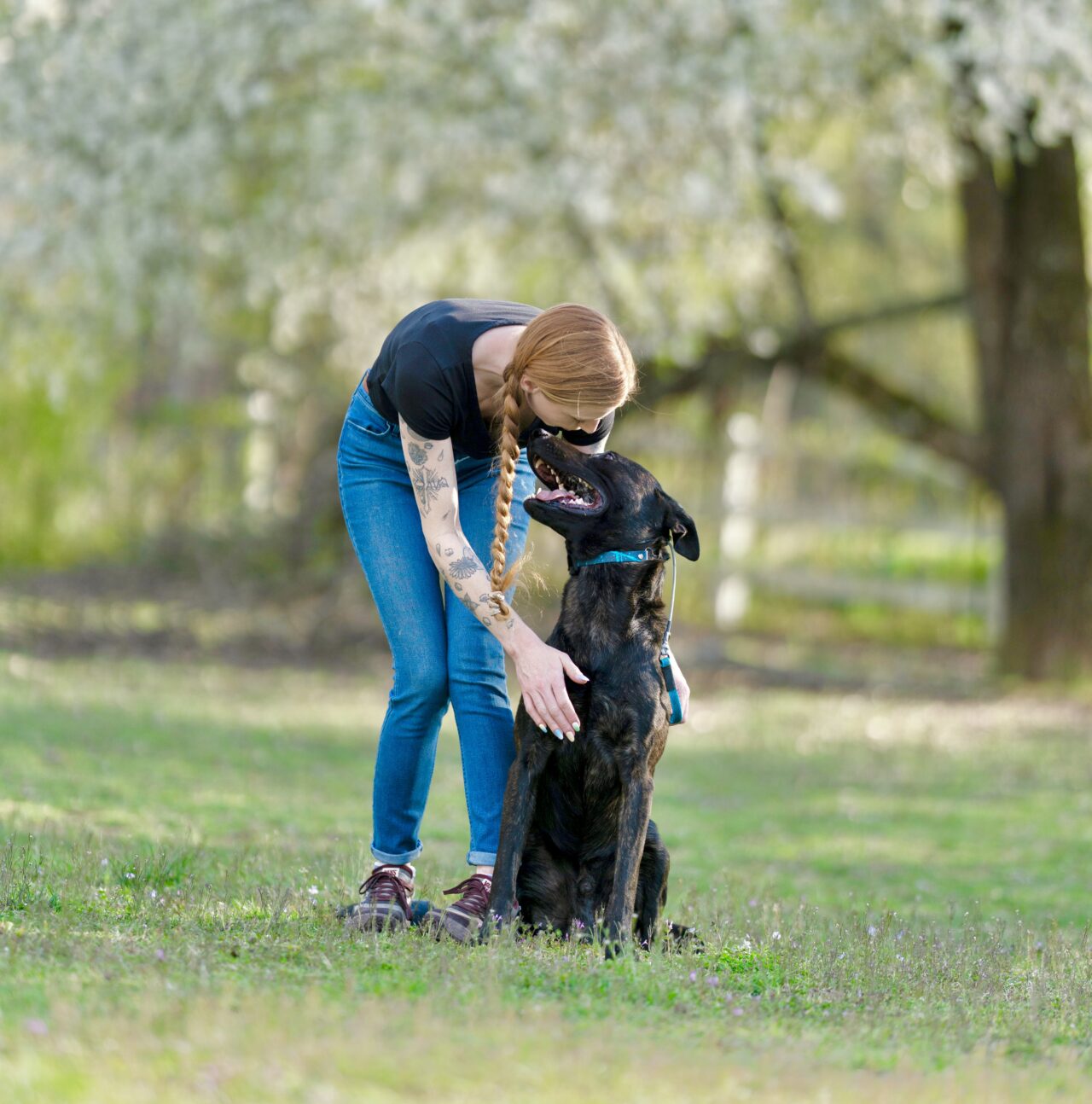When it comes to training our dogs, we all want to choose the best, most effective methods—not just for us, but for their overall well-being. Many modern dog trainers advocate for an approach called “purely positive” dog training, which eliminates the use of corrections or aversive tools entirely, relying only on rewards and positive reinforcement. While the intention behind this method is undoubtedly kindhearted, problems arise when we rely exclusively on this one-sided approach.
This blog aims to shed light on the shortcomings of purely positive training and demonstrate why balanced training, a method that integrates both positive reinforcement and corrective measures, offers a safer, more effective path for both dogs and owners.
What is Purely Positive Dog Training?
Purely positive dog training relies solely on positive reinforcement to encourage desired behaviors. Techniques typically involve offering treats, toys, or praise to reward good behavior while entirely avoiding corrections. At its core, this method seeks to create a positive, fear-free environment for teaching dogs to behave appropriately.
While there’s much to appreciate about positive reinforcement, problems arise when real-world challenges and complex behaviors demand training approaches beyond just rewards.
The Real-World Limitations of Pure Positive Training
Behavioral Issues Are Not Always Addressed Effectively
Purely positive training is highly effective for teaching new behaviors or working with fearful or shy dogs. However, when it comes to stopping complex or dangerous behaviors—such as biting, excessive barking, leash pulling, or aggressive outbursts—this method often falls short.
Take, for example, an overly playful dog that bites during interactions. Purely positive options like teaching a “leave it” command, redirecting behavior with a toy, or withdrawing attention are helpful, but what if you’re in a situation where you can’t control the environment? What happens if the dog ignores the commands entirely? Some behaviors require swift and appropriate corrections to ensure the safety of both the dog and their owner.
Strategies like using a prong collar or an e-collar which the dog has been properly conditioned to combined with immediate positive reinforcement upon stopping the undesired behavior allow for effective and balanced training. These methods replace months of stress with quicker, lasting results.
Recall Training Can Save Lives
Teaching a reliable “Here” command can literally save your dog’s life, especially in high-stakes real-world situations. While positive reinforcement helps build this command with practice and repetition, it often lacks the reliability required when distractions are present.
Picture this scenario—your dog bolts after a rabbit, heading straight toward traffic. No amount of praise, treats, or toys will matter if they are hyper-focused on the chase. A balanced method can include an e-collar correction at the moment the recall cue is ignored. This may sound harsh to advocates of pure positive training, but what’s worse—momentary discomfort or risking your dog’s life?
Balanced training ensures that commands like “Here” remain reliable, no matter the distractions or circumstances.
Why Balanced Training is the Safer, More Effective Approach
Training Methods Tailored to the Dog
Every dog is unique, from their temperament to their learning style. Just as no two humans learn the same way, dogs adapt best to training that considers their individual needs. Balanced training blends the best of positive reinforcement with corrections to create a holistic, adaptable methodology.
For example:
-
High-energy or reactive dogs may require spatial or leash pressure alongside rewards to remain focused.
-
Fearful dogs benefit significantly from counter-conditioning and rewards but may also need firmer boundaries to build confidence.
Simply put, balanced training gives trainers more tools to address behavioral challenges effectively and humanely.
Faster Results Without Sacrificing Kindness
Positive-only methods often take months (or even years) to yield consistent results(If any at all), especially when attempting to stop dangerous or ingrained behaviors. By incorporating corrections appropriately, balanced training achieves better results both faster and more efficiently.
Imagine resolving leash-pulling issues in a few structured training sessions rather than spending months with little to no progress. Both owners and dogs win when solutions are implemented thoughtfully and with care.
Promoting Safety Above All Else
Blindly following an ideology that forbids all forms of correction can lead to preventable outcomes—for example, dogs surrendered to shelters, rehomed repeatedly, or euthanized due to behaviors that could have been fixed. No “humane hierarchy” should prioritize ideology over actual safety.
Balanced training empowers owners to achieve a greater level of control and safety for their dogs, which leads to stronger relationships and peaceful coexistence.
Debunking the Myths Around Corrections
Advocates of purely positive training often argue that any form of punishment will make a dog fearful or aggressive and ruin the bond between dog and owner. However, these claims lack nuance and oversimplify the reality of behavioral science.
-
The Truth About Punishment
When used correctly and proportionately, corrective measures are not harmful or inhumane. For example, the light pressure of a prong collar or a brief stimulation from an e-collar is much less harmful than allowing a dog to continue dangerous behaviors, such as lunging at other dogs or chasing cars.
-
Corrections Improve Clarity
Corrections help set clear boundaries. Dogs thrive on structure and need to understand the link between their actions and their consequences. Properly balanced training builds trust and clarity while eliminating confusion.
-
The Bond Is Strengthened, Not Broken
When owners implement training that is fair, consistent, and rooted in clear communication, the trust between them and their dog grows stronger. Dogs understand that their owners are reliable leaders who ensure their safety and well-being.
Positive Reinforcement Still Has Its Place
Balanced training doesn’t mean punishment-only approaches. Positive reinforcement remains the gold standard for teaching new behaviors, building trust, and reinforcing desirable actions. The issue lies in depending solely on it to address everything.
Effective training recognizes both the power and the limitations of positive reinforcement and complements it with tools that promote safety, reliability, and long-term success.
Final Thoughts
Purely positive dog training comes from a place of compassion but lacks the practicality required for real-world challenges. A balanced approach, which combines positive reinforcement with appropriate corrections, offers a more effective and humane solution. By using the right tools and techniques, we give dogs the structure they need to thrive while keeping both them and their owners safe.
Your dog deserves the best training possible—one rooted in fairness, kindness, and practicality. If you’re dealing with challenging behaviors or want guidance on balanced training, consult with one of GADD’s professional trainers who are equipped to find solutions tailored to your dog.
Studies vs Experience
When it comes to dog training, there is often a heated debate between relying solely on scientific studies versus personal experience in the field. While research provides invaluable data and foundational knowledge, it cannot account for every real-life scenario that trainers and dog owners encounter. Studies are typically conducted under controlled conditions, which fail to replicate the unpredictable nature of daily life with dogs. On the other hand, an experienced trainer brings a wealth of hands-on insights gained from interacting with a wide variety of dogs in diverse situations. Dismissing one in favor of the other creates unnecessary polarization. Instead, the ideal approach combines scientific evidence to guide general practices with the nuanced judgment that experience brings to address individual cases effectively. Dog training is not a one-size-fits-all process, and learning to balance studies with expertise leads to the best outcomes for dogs and their owners.
Parent vs Friend/Respect vs Love
There’s an inherent balance that every dog owner must strive to achieve—acting as both a guide and a source of love for their dog. The role of a dog owner can often be compared to that of a parent and a friend. Being respected does not mean instilling fear, just as being loved does not mean permitting unchecked behavior. Modern society tends to lean hard toward pampering dogs in an attempt to strengthen the bond of love, often overlooking the necessity of structure and leadership. Dogs thrive with clear boundaries and consistent rules; these create security and confidence within their environment. Instead of viewing respect and love as mutually exclusive, they should be seen as complementary elements. Respect comes from a well-structured relationship, while love is the reward for building trust and partnership. Both aspects foster a healthy, fulfilling life for a dog.
Replacement Behaviors
One major tenet of effective dog training is not only stopping undesirable behaviors but also replacing them with appropriate ones. Dogs don’t always understand what we “don’t want” but can more easily grasp what we “do want” with clear communication and consistency. For instance, instead of simply preventing a dog from jumping on guests, teach it to sit calmly to greet people. Replacement behaviors not only help avoid frustration during training but also redirect the dog’s energy in a productive manner. This approach makes learning far more effective because it allows the dog to channel its instincts and drive into behaviors that align with expectations. Replacement behaviors serve as a bridge between correcting undesirable actions and nurturing behaviors that allow the dog to successfully adapt to its environment while maintaining a positive relationship with its owner.


